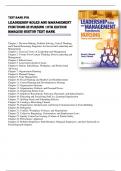Test Bank for
Leadership Roles and Management
Functions in Nursing 10th Edition
M
Marquis Huston Test Bank
ED
Chapter 1: Decision Making, Problem Solving, Critical Thinking,
and Clinical Reasoning: Requisites for Successful Leadership and
Management
Chapter 2: Classical Views of Leadership and Management
Chapter 3: Twenty-First-Century Thinking About Leadership and
C
Management
Chapter 4: Ethical Issues
Chapter 5: Legal and Legislative Issues
O
Chapter 6: Patient, Subordinate, Workplace, and Professional
Advocacy
Chapter 7: Organization Planning
N
Chapter 8: Planned Change
Chapter 9: Time Management
Chapter 10: Fiscal Planning and Health-Care Reimbursement
N
Chapter 11: Career Planning and Development in Nursing
Chapter 12: Organization Structure
Chapter 13: Organization, Political, and Personal Power
O
Chapter 14: Organizing Patient Care
Chapter 15: Employee Recruitment, Selection, Placement, and Indoctrination
Chapter 16: Educating and Socializing Staff in a Learning Organization
IS
Chapter 17: Staffing Needs and Scheduling Policies
Chapter 18: Creating a Motivating Climate
Chapter 19: Organization, Interpersonal, and Group Communication in Team Building
Chapter 20: Delegation
SE
Chapter 21: Conflict, Workplace Violence, and Negotiations
Chapter 22: Collective Bargaining, Unionization, and Employment Laws
Chapter 23: Quality Control in Creating a Culture of Patient Safety
Chapter 24: Performance Appraisal
Chapter 25: Problem Employees: Rule Breakers, Marginal Employees, and the Chemically or
U
Psychologically Impaire
R
, Chapter 1 Decision Making, Problem Solving, Critical Thinking, and Clinical Reasoning:
Requisites for successful leadership and management
1. What statement is true regarding decision making?
A) It is an analysis of a situation
M
B) It is closely related to evaluation
C) It involves choosing between courses of action
ED
D) It is dependent upon finding the cause of a problem Ans: C
Feedback:
Decision making is a complex cognitive process often defined as choosing a particular course
C
of action. Problem solving is part of decision making and is a systematic process that focuses
on analyzing a difficult situation. Critical thinking, sometimes referred to as reflective
O
thinking, is related to evaluation and has a broader scope than decision making and problem
solving.
N
2. What
N
1. A) Its need for implementation time
2. B) Its lack of a step requiring evaluation of results
O
3. C) Its failure to gather sufficient data
4. D) Its failure to evaluate alternatives
IS
Ans: A
Feedback:
SE
The traditional problem-solving model is less effective when time constraints are a
consideration. Decision making can occur without the full analysis required in problem
solving. Because problem solving attempts to identify the root problem in situations, much
time and energy are spent on identifying the real problem.
U
3. Which of the following statements is true regarding decision making?
R
1. A) Scientific methods provide identical decisions by different individuals for the
same problems
, 2. B) Decisions are greatly influenced by each persons value system
3. C) Personal beliefs can be adjusted for when the scientific approach to problem
solving is used
M
4. D) Past experience has little to do with the quality of the decision
ED
Ans: B
Feedback:
Values, life experience, individual preference, and individual ways of thinking will influence
a persons decision making. No matter how objective the criteria will be, value judgments will
C
always play a part in a persons decision making, either consciously or subconsciously.
O
is a weakness of the traditional problem-solving model?
Page 1
N
4. What influences the quality of a decision most often? A) The decision makers immediate
N
superior
B) The type of decision that needs to be made
O
C) Questions asked and alternatives generated
D) The time of day the decision is made
IS
Ans: C
Feedback:
The greater the number of alternatives that can be generated by the decision maker, the better
SE
the final decision will be. The alternatives generated and the final choices are limited by each
persons value system.
5. What
U
1. A) Good decision makers are usually right-brain, intuitive thinkers
R
2. B) Effective decision makers are sensitive to the situation and to others
3. C) Good decisions are usually made by left-brain, logical thinkers
4. D) Good decision making requires analytical rather than creative processes
Ans: B
Feedback:
Good decision makers seem to have antennae that make them particularly sensitive to other
, people and situations. Left-brain thinkers are typically better at processing language, logic,
numbers, and sequential ordering, whereas right-brain thinkers excel at nonverbal ideation
and holistic synthesizing.
M
does knowledge about good decision making lead one to believe?
6. What
ED
1. A) The planning process of management
2. B) The evaluation phase of the executive role
3. C) One step in the problem-solving process
C
4. D) Required to justify the need for scarce items
O
Ans: C
Feedback:
Decision making is a complex, cognitive process often defined as choosing a particular
N
course of action. Decision making, one step in the problem-solving process, is an important
task that relies heavily on critical thinking and clinical reasoning skills.
N
is the best definition of decision making?
O
Page 2
IS
7. If decision making is triggered by a problem with what does it end?
1. A) An alternative problem
SE
2. B) A chosen course of action
3. C) An action that guarantees success
4. D) A restatement of the solution
U
Ans: B
Feedback:
R
A decision is made when a course of action has been chosen. Problem solving is part of
decision making and is a systematic process that focuses on analyzing a difficult situation.
Problem solving always includes a decision-making step.
8. Why do our values often cause personal conflict in decision making?
1. A) Some values are not realistic or healthy




